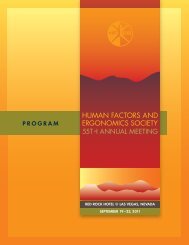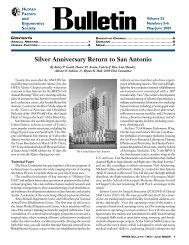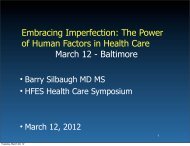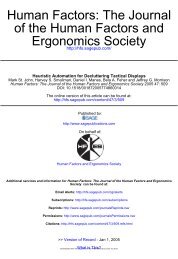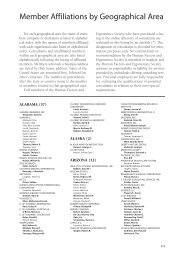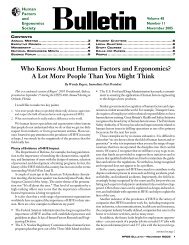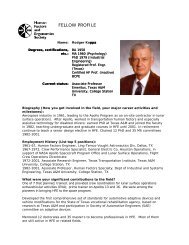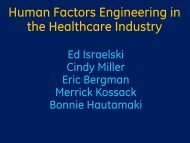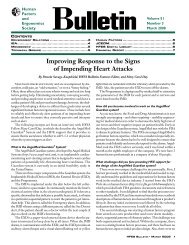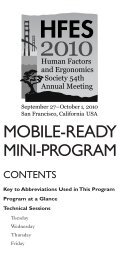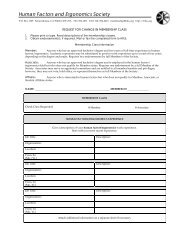From Past to Future - Human Factors and Ergonomics Society
From Past to Future - Human Factors and Ergonomics Society
From Past to Future - Human Factors and Ergonomics Society
- No tags were found...
You also want an ePaper? Increase the reach of your titles
YUMPU automatically turns print PDFs into web optimized ePapers that Google loves.
<strong>Human</strong>Fac<strong>to</strong>rs<strong>and</strong><strong>Ergonomics</strong><strong>Society</strong>BulletinVolume 49Number 11November 2006CONTENTSANNUAL MEETING ........................................3HUMAN FACTORS .........................................4NATIONAL ERGONOMICS MONTH .......................5MEMBERSHIP ..............................................6CALLS FOR PAPERS ......................................6<strong>From</strong> <strong>Past</strong> <strong>to</strong> <strong>Future</strong>:Building a Collective Vision for HFES 2020+By Waldemar Karwowski, HFES PresidentAs we approached the 50th Annual Meeting, recentlycelebrated in San Francisco, our <strong>Society</strong> examinedmany of its past accomplishments. <strong>From</strong> thisintrospection, we have gained a better appreciationfor the various contributions our members havemade <strong>to</strong> the discipline <strong>and</strong> profession over the last50 years. As your 50th president, I am honored <strong>to</strong>join you as we make his<strong>to</strong>ry over the next 50 years.To properly begin this journey, I propose that wecollaborate <strong>to</strong> develop a unified vision for our discipline,our profession, <strong>and</strong> our <strong>Society</strong> – “a collectivevision for HFES 2020+.” To move in this direction,we should pause <strong>and</strong> examine some of the criticalissues that have surfaced in recent years. These issues are illustratedby the following questions:• Where is the human fac<strong>to</strong>rs/ergonomics (HF/E) disciplineheading?• How do we develop the HF/E profession <strong>to</strong> its fullest?• How can HFES act as a leader in HF/E development?• How can HFES add value <strong>to</strong> the global society at large?As a starting point, let me discuss our mission <strong>and</strong> vision statements.Our mission is “<strong>to</strong> help our members advance the science,philosophy, <strong>and</strong> practice of human-centered design.” Furthermore,“we envision a widely shared science, philosophy, <strong>and</strong>practice that adapt technology <strong>to</strong> enhance human performance<strong>and</strong> improve the quality of human life” (2003 HFES StrategicPlanning Day). Assuming that our goals are reflected in thesestatements, what technology in particular should we aim <strong>to</strong> adaptin order <strong>to</strong> optimize human well-being <strong>and</strong> system performance? At amore fundamental level, do we underst<strong>and</strong> <strong>and</strong> can we effectivelycope with the rapidly converging technologies of <strong>to</strong>day, such asinformation technology, biotechnology, <strong>and</strong> nanotechnology (seeRoco & Bainbridge, 2003)? Finally, from a global perspective, dowe underst<strong>and</strong> the world in which we live? Can we predict the roleof technology in its future?Looking Ahead: Nanoergonomics?At this moment, we are witnessing the beginning of a technologicalrevolution made possible by developments in nanoscience<strong>and</strong> nanotechnology that make it possible <strong>to</strong> manipulatematter at the molecular (10 -9 meter) level (seeNational Research Council, 2002). Much as was thecase with previous technological advances, the potentialeffects of nanotechnology cannot be fully appreciated<strong>to</strong>day. For example, when it was invented in1948, no one could appreciate the tremendous impact<strong>and</strong> benefit the transis<strong>to</strong>r would have. Almost60 years later, we have seen this simple yet brilliantinvention become the basis for information technology.Consequently, we have witnessed the advent ofthe Internet <strong>and</strong> Web, which have made our worldseemingly flat (see Friedman, 2002).Although we may not grasp its potential reach, we can venture<strong>to</strong> speculate that the nanotechnological revolution will profoundlyaffect not only our everyday lives but also the science <strong>and</strong> practiceof human fac<strong>to</strong>rs/ergonomics. Examples include the developmen<strong>to</strong>f intelligent, evolvable, <strong>and</strong> adaptive systems across many humanendeavors, including computing <strong>and</strong> data s<strong>to</strong>rage, materials <strong>and</strong>manufacturing, health <strong>and</strong> medicine, energy <strong>and</strong> the environment,transportation, national security, <strong>and</strong> space exploration (NationalAcademy of Engineering, 2004).Developments in technology have a direct impact on our owndiscipline by directly or indirectly facilitating the expansion of ourexisting knowledge base, theory, <strong>and</strong> subsequent applications. Aquick overview of HF/E his<strong>to</strong>rical trends confirms this position,as our field has evolved from the physical <strong>and</strong> perceptual <strong>to</strong> thecognitive; from system design orientation <strong>and</strong> macroergonomics<strong>to</strong> ecological, affective, <strong>and</strong> information ergonomics. The mostrecent illustration of technology stimulating the evolution of ourfield is the advent of neuroergonomics (Parasuraman, 2003). I amconfident that we will continue this theme <strong>and</strong> successfully adaptnanotechnology <strong>to</strong> enhance human performance <strong>and</strong> improve thequality of human life by developing <strong>and</strong> applying a new domain:nanoergonomics (Karwowski, 2005).But how will nanotechnology affect what we do? <strong>From</strong> theHF/E point of view, nanotechnology may enable us <strong>to</strong> access thehuman central nervous system in order <strong>to</strong> preserve <strong>and</strong> enhanceour perceptual <strong>and</strong> cognitive abilities, integrate important featuresof human cognition in<strong>to</strong> machines, or develop cognitive prosthetics<strong>to</strong> enhance human performance (Roco & Bainbridge, 2003).continued on page 2HFES BULLETIN • NOVEMBER 2006 1
<strong>From</strong> <strong>Past</strong> <strong>to</strong> <strong>Future</strong>: Building a Collective Vision...(continued from page 1)For example, by mapping the single-cell recordings of neural responses<strong>to</strong> different stimuli, we may be able <strong>to</strong> deduce how sensoryinformation is processed <strong>and</strong> muscles are controlled – data thatare critical in the prevention of musculoskeletal injury.HFES Meeting the Needs of the <strong>Future</strong>In order <strong>to</strong> meet the goal of developing a unified vision, theHFES Executive Council is forming a task force that, first, willexamine the direction HF/E is headed by considering opportunities<strong>and</strong> challenges for research <strong>and</strong> practice, <strong>and</strong>, second, developa vision for the future of our discipline in 2020+. Your input <strong>to</strong> thistask force is essential <strong>and</strong> will be very much appreciated (pleasesend your comments <strong>to</strong> wkarwowski@hfes.org).On a global scale, our profession faces challenging questionsrelated <strong>to</strong> how we can contribute <strong>to</strong> the betterment of society atlarge. Although technological advancement has the potential <strong>to</strong>improve the human condition, its inherent danger lies in its ability<strong>to</strong> create unforeseen consequences. Our aim in HF/E is <strong>to</strong>minimize the unwanted consequences of trends in contemporaryscience, engineering, <strong>and</strong> technology, as predicted by the JapanMinistry of Education, Science <strong>and</strong> Technology (2000):• “Developments in genetics (DNA, human evolution, creationof an artificial life, outer space exploration, living outside Earth)• Developments in neurosciences (human cognitive processesthrough artificial systems)• Revolution in medicine <strong>and</strong> health care (cell <strong>and</strong> organ regeneration,nanorobotics for diagnostics <strong>and</strong> therapy, superprosthesis)• Elimination of starvation <strong>and</strong> malnutrition (artificial pho<strong>to</strong>synthesisof foods, safe genetic foods manipulation)• Full recycling of resources <strong>and</strong> reusable energy (biomass/nanotechnology)• Planning for new human habitats (outer space cities, 100% undergroundindustrial manufacturing, separation of human habitatfrom natural environments, protection of diversity of lifeforms on Earth)• Clean-up of the negative effects of 20th century on environment(organisms for environmental cleaning, regeneration ofthe ozone)<strong>Human</strong>Fac<strong>to</strong>rs<strong>and</strong><strong>Ergonomics</strong><strong>Society</strong>BulletinVolume 49, Number 11 November 2006The HFES Bulletin (ISSN 1527-3660) is published 11 times a year by the <strong>Human</strong> Fac<strong>to</strong>rs<strong>and</strong> <strong>Ergonomics</strong> <strong>Society</strong>, 1124 Montana Ave., Suite B, Santa Monica, CA 90403 USA,http://hfes.org. Address inquiries <strong>and</strong> address changes <strong>to</strong> HFES, P.O. Box 1369, SantaMonica, CA 90406-1369 USA, 310/394-1811, fax 310/394-2410, http://hfes.org.Copyright © 2006 by the <strong>Human</strong> Fac<strong>to</strong>rs <strong>and</strong> <strong>Ergonomics</strong> <strong>Society</strong>. Printed in the USA.The HFES Bulletin is provided <strong>to</strong> members of the <strong>Society</strong> ($10 of annual dues coversmember subscriptions); nonmembers may subscribe for $40/year. Periodicals postagepaid at Santa Monica, CA, <strong>and</strong> additional mailing offices. USPS #018-206.• Communication (nonverbal communication technology, virtualpresence systems)• Computerized democracy• Transportation <strong>and</strong> travel (natural sources of clean energy,au<strong>to</strong>mated transport systems, revolution in supersonic smallaircraft <strong>and</strong> supersonic travel, underwater ocean travel)• Safety <strong>and</strong> control over one’s life (prevention of crime by brainintervention, human error avoidance technology, control ofthe forces of nature, truly intelligent systems for safety in allforms of transport).”In adding value <strong>to</strong> the global society at large, we should determinehow HFES can lead the development of the HF/E discipline<strong>and</strong> profession. In order <strong>to</strong> address the <strong>Society</strong>’s role in HF/Edevelopment, we need <strong>to</strong> examine our own purpose as we defineit <strong>to</strong>day. In simple terms, our society exists in order <strong>to</strong> advance <strong>and</strong>represent the HF/E discipline <strong>and</strong> serve our members. How well dowe actually fulfill this purpose? HFES is a complex organizationguided by our mission, vision, <strong>and</strong> strategic goals. These goals includethe following:• Science <strong>and</strong> Practice Goal: Advance both the science <strong>and</strong> practiceof HF/E <strong>to</strong> maintain HFES as the premier scientific bodyin the field.• Education <strong>and</strong> Training Goal: Promote the teaching of HF/Escience, philosophy, <strong>and</strong> practice.• Peer Networking Goal: Promote the evaluation <strong>and</strong> exchangeof information among HF/E researchers <strong>and</strong> practitioners.• Outreach Goal: Promote the exchange of information betweenHF/E professionals <strong>and</strong> those who need our services.• Organizational Excellence Goal: Serve <strong>and</strong> represent the membersas the premier scientific, engineering, <strong>and</strong> practice society.How are these goals translated in<strong>to</strong> the operational rules responsiblefor the day-<strong>to</strong>-day functioning of our organization? According<strong>to</strong> Nolan et al. (1993), the “strategic decisions determinewhat an organization will do – the leadership task – <strong>and</strong> tacticaldecisions determine how it will be done – the administra<strong>to</strong>r’s ormanager’s task.” Furthermore, what worked well over the last 50years may not be (<strong>and</strong> probably is not) what our organization needs<strong>to</strong> function in <strong>to</strong>day’s world.Our overall strategy defines what we do in the future, <strong>and</strong> definingit is the responsibility of not only the HFES leadership butall members of our <strong>Society</strong>. By devoting a strategic planning dayat the midyear Executive Council meeting this past April, we havestarted <strong>to</strong> lay the groundwork for the process of building a collectivevision for HFES 2020+. I hope we will continue in this directionin the years <strong>to</strong> come.Setting the Direction for the Next 50 YearsDeveloping a collective vision for the future of HFES requiresthat we focus our attention on the following issues:• Where should HFES be going?• How can we take our <strong>Society</strong> <strong>to</strong> a new <strong>and</strong> better place?• How do we get there?• What changes (if any) are needed?• What are the current <strong>and</strong> future barriers <strong>to</strong> such changeswithin HFES?• What are our core values that will guide the process of change?2 HFES BULLETIN • NOVEMBER 2006
In order <strong>to</strong> effectively address these questions, I believe weneed <strong>to</strong> empower HFES members <strong>to</strong> do what they do best. Toempower means <strong>to</strong> equip or supply with ability, <strong>to</strong> enable. Howwe empower various HFES constituencies <strong>and</strong> our individual members,<strong>and</strong> how we facilitate their use of respective talents <strong>to</strong> contribute<strong>to</strong> our <strong>Society</strong>, becomes a critical point for the success ofour organization <strong>and</strong> its future.Responses <strong>to</strong> the blast e-mail questionnaire that I sent in Marchconfirm that HFES members overwhelmingly desire <strong>to</strong> be involvedin <strong>Society</strong> affairs. Our <strong>Society</strong> greatly benefits from thisstrong desire. Although at times we consider the question, “Whocares about our discipline <strong>and</strong> our profession?” the clear answer isthat we all do. Additional challenges we must confront <strong>and</strong> overcomeinclude those pointed out in response <strong>to</strong> the questionnaire:• Where will our future members come from?• What is the trade-off between the values of HFES membershipversus cost?• How can we better serve the needs of members who are practitioners?• How can we ensure open <strong>and</strong> effective two-way communicationbetween the <strong>Society</strong>’s leadership <strong>and</strong> its members at large?• How can we facilitate the expansion of research <strong>and</strong> applications?• How can we advance public advocacy, address social issues, <strong>and</strong>effectively promote our discipline <strong>and</strong> profession?• How can HFES, as the premier organization representing thehuman fac<strong>to</strong>rs/ergonomics profession, help <strong>to</strong> develop HF/Eliteratecitizens in the United States <strong>and</strong> around the world?<strong>From</strong> an organizational st<strong>and</strong>point, we strive <strong>to</strong> streamline action<strong>and</strong> minimize disruption. Hence, the question of efficiencyarises: What might be missing in the current HFES structure <strong>and</strong>mode of everyday functioning that prevents us from effectivelyempowering our organizational components (i.e., committees<strong>and</strong> individuals)? What rules <strong>and</strong> procedures may need <strong>to</strong> bechanged <strong>to</strong> empower our various constituencies? I invite <strong>and</strong> hope<strong>to</strong> hear your advice, comments, opinions, concerns, <strong>and</strong> ideasabout the future of HFES.While in San Francisco, the Executive Council decided <strong>to</strong> restructureitself in order <strong>to</strong> better perform its legislative functions,with a clear focus on developing <strong>and</strong> continuously adapting strategiesin response <strong>to</strong> dynamic changes occurring in the outsideworld. Furthermore, we are in the process of forming several taskforces whose roles will include examining our needs <strong>and</strong> developinga vision in the following targeted areas: technical groups, annualmeetings, the <strong>Society</strong> Web site, <strong>and</strong> opportunities for HF/Epractitioners.Looking inward, we need <strong>to</strong> address the question of what constitutesour core values. The core values, which are the soul of anyorganization, are a set of attitudes <strong>and</strong> beliefs that influence theway our members <strong>and</strong> various HFES constituencies behave now<strong>and</strong> in the future. Reflecting on our culture, we should ask if theseare our core values:• Openness of ideas• Flexibility <strong>and</strong> diversity of thought• Transparency of rules <strong>and</strong> procedures• Ability <strong>to</strong> think big• Ability <strong>to</strong> plan for <strong>and</strong> realize changes• Introspection <strong>and</strong> reflection• Two-way communication with membersAlthough developing a vision for the HF/E discipline, theHF/E profession, <strong>and</strong> HFES itself will require persistence <strong>and</strong>patience, it will definitively help us <strong>to</strong> remove existing barriers <strong>to</strong>change, empower members <strong>to</strong> utilize their unique skills <strong>to</strong> contribute<strong>to</strong> our organization, follow our core values of openness <strong>and</strong>transparency, <strong>and</strong> facilitate the process of reinventing our technicalgroups, developing a world-class Web site, enhancing our annualmeetings, better addressing the needs of practitioners, <strong>and</strong> achievinggreater social impact worldwide.This is a call <strong>to</strong> action for all of us. Please share with me youropinions regarding how we can better serve our discipline <strong>and</strong>profession, where HFES should aspire <strong>to</strong> be in the year 2020+,<strong>and</strong> how we can achieve this vision.This is your <strong>Society</strong> – take it.Waldemar Karwowski is professor of industrial engineering <strong>and</strong> direc<strong>to</strong>rof the Center for Industrial <strong>Ergonomics</strong> at the University of Louisville.He may be reached at wkarwowski@hfes.org.ReferencesFriedman, T. L. (2006). The world is flat: A brief his<strong>to</strong>ry of the twenty-first century.New York: Farrar Straus Giroux.Japan Ministry of Education, Science <strong>and</strong> Technology. (2000). Major productionsfor science <strong>and</strong> technology in the 21st century. Tokyo: Author.Karwowski, W. (2005). <strong>Ergonomics</strong> <strong>and</strong> human fac<strong>to</strong>rs: The paradigms forscience, engineering, design, technology, <strong>and</strong> management of humancompatiblesystems. <strong>Ergonomics</strong>, 48, 436–463.National Research Council. (2002). Small wonders, endless frontiers: A review ofthe National Nanotechnology Initiative. Washing<strong>to</strong>n, DC: National AcademyPress.National Academy of Engineering. (2004). The engineer of 2020: Visions ofengineering in the new century. Washing<strong>to</strong>n, DC: National Academy Press.Nolan, T., Goodstein, L., & Pfeiffer, S. (1993). Plan or die! 10 keys <strong>to</strong> organizationalsuccess. Toron<strong>to</strong>: Pfeiffer & Co.Parasuraman, R. (2003). Neuroergonomics: Research <strong>and</strong> practice. TheoreticalIssues in <strong>Ergonomics</strong> Science, 4, 5–20.Roco, M. C., & Bainbridge, W. S. (Eds.). (2003). Converging technologies forimproving human performance. Bos<strong>to</strong>n: Kluwer.ANNUAL MEETINGPreliminary Call for Proposals:51st Annual MeetingThe <strong>Human</strong> Fac<strong>to</strong>rs <strong>and</strong> <strong>Ergonomics</strong> <strong>Society</strong>’s Annual Meetingis the primary gathering of researchers <strong>and</strong> practitioners inthe field of human fac<strong>to</strong>rs/ergonomics <strong>and</strong> related areas. The 51stAnnual Meeting, which takes place Oc<strong>to</strong>ber 1–5, 2007, at the BaltimoreWaterfront Marriott Hotel, continues the <strong>Society</strong>’s celebrationsin honor of the 50th anniversary with further explorationsof our his<strong>to</strong>rical foundations <strong>and</strong> vision for the future of our profession.The Technical Program Committee encourages creativeproposals for program materials of all kinds.New formats for presenting human fac<strong>to</strong>rs/ergonomics (HF/E)HFES BULLETIN • NOVEMBER 2006 3
ANNUAL MEETING, cont.efforts are strongly encouraged. Participants are invited <strong>to</strong> submitproposals including case studies, debates, demonstrations, competitiveproduct designs, new methodologies, on-site experiments,<strong>and</strong> posters involving both fixed <strong>and</strong> dynamic information presentation.Examples of recent innovative formats include “You Have5 Minutes <strong>to</strong> Convince Me” <strong>and</strong> the 2006 Design Chautauqua.Key DatesThe fully detailed Call for Proposals will be available at theHFES Web site the week of December 4, 2007. The deadline forsubmitting any type of proposal is February 12. Acceptance/rejectionletters will be sent in mid-April. Proceedings papers will bedue in June.New for 2007: Proposal FormattingIn response <strong>to</strong> feedback from past presenters, the TechnicalProgram Committee has implemented a change in the proposalsubmission process. Proposers will be required <strong>to</strong> format the150-word abstract <strong>and</strong> 2000-word presentation in the same twocolumnlayout that applies <strong>to</strong> proceedings papers, with the samefive-page limit. If a proposal is accepted, the author would updatethe proposal based on reviewer comments <strong>and</strong> then upload thefinal version for publication in the proceedings. This applies <strong>to</strong> allpresentation types (lecture, invited symposium, discussion panel,poster, demonstration, etc.).Submitting ProposalsDetailed instructions for submitting materials will be includedin the online Call for Proposals. All submissions will be uploaded<strong>to</strong> a Web site <strong>to</strong> be listed in the instructions. You must have ane-mail address <strong>to</strong> submit a proposal because all correspondenceregarding your submission will be done via e-mail.A single contribu<strong>to</strong>r will be responsible for uploading eachsubmission, including full-session invited symposia. In order <strong>to</strong>reduce confusion between authors, reviewers, <strong>and</strong> others, contribu<strong>to</strong>rsof full sessions are encouraged <strong>to</strong> collect materials from allauthors or symposium members <strong>and</strong> upload them <strong>to</strong> the Web site.Papers that have been published previously or presented atanother professional meeting may not be submitted. All research<strong>and</strong> analyses described in your proposal must be complete at thetime the proposal is submitted. Program Chairs may reject, with orwithout review, papers that do not present completed work. Thesole exception <strong>to</strong> this policy is for student work submitted for considerationin the Student Forum track, in which case the proposermay report on work in progress.Note that for all accepted submissions, one of the authors mustattend the meeting <strong>to</strong> present the work. All presenters are required<strong>to</strong> pay the meeting registration fee (but see below regarding nonmemberpresenters who attend one day only).If you know of nonmembers who might be interested in submittinga proposal, please send their contact information <strong>to</strong> theCommunications Department (lois@hfes.org, 310/394-1811), <strong>and</strong>we will invite them <strong>to</strong> submit their work.A nonmember whose work is accepted <strong>and</strong> who plans <strong>to</strong> attendonly on the day of his or her presentation may request a waiver ofthe one-day nonmember registration fee.Proceedings Publication <strong>and</strong> HFES CopyrightIn May, authors of accepted proposals will receive instructionsfor uploading their final, revised submissions for publication in theproceedings CD-ROM. There is a strict five-page limit.HFES requires a transfer of copyright unless the work was performedby U.S. government employees or by employees of non-U.S. government agencies. However, the author may reuse thematerial for any purpose without restriction or fee. If you havequestions about the HFES copyright transfer policy, please contactthe HFES Communications Department (310/394-1811,lois@hfes.org).HUMAN FACTORSWhat’s New at <strong>Human</strong> Fac<strong>to</strong>rs?By Nancy Cooke, Edi<strong>to</strong>rIt is hard <strong>to</strong> believe that it has been nearly two years since I<strong>to</strong>ok on the edi<strong>to</strong>rship of <strong>Human</strong> Fac<strong>to</strong>rs. It has been a very productivetwo years, <strong>and</strong> I continue <strong>to</strong> be amazed at the quality of materialsubmitted <strong>to</strong> the journal <strong>and</strong> the excellent feedback providedby the journal staff, reviewers, edi<strong>to</strong>rial board members, <strong>and</strong> associateedi<strong>to</strong>rs. All this hard work pays off in a high-quality scholarlyjournal.We continue <strong>to</strong> explore ideas for increasing the impact of thejournal, recognizing that this is a strategic objective of HFES <strong>and</strong>a very important consideration for academics. Although it is <strong>to</strong>oearly <strong>to</strong> take credit for it, I note that the 2005 impact fac<strong>to</strong>r of .777is up a few points from the 2004 figure of .747, <strong>and</strong> this is encouraging.But we have a long way <strong>to</strong> go in terms of impact. We’reworking on a running list of ideas for improving impact, with mostnotable recent efforts focused on drawing attention <strong>to</strong> “hot <strong>to</strong>pics”through press releases <strong>and</strong> <strong>to</strong> decreasing production lag by addingpages <strong>and</strong> increasing the frequency of publication.Specifically, since November 2004, when HFES began usingManuscript Central for paper submission <strong>and</strong> review, we have experiencedan increase in submissions <strong>to</strong> <strong>Human</strong> Fac<strong>to</strong>rs <strong>and</strong> a reductionin the time from submission <strong>to</strong> acceptance. The result hasbeen an increase in the backlog of accepted manuscripts. ThePublications Committee <strong>to</strong>ok steps <strong>to</strong> address the backlog recentlywhen it proposed <strong>to</strong> the HFES Executive Council that the journalaccommodate more material. Council agreed, <strong>and</strong> as a result,we will begin publishing <strong>Human</strong> Fac<strong>to</strong>rs on a bimonthly schedulebeginning in 2007. Issues will appear in February, April, June, August,Oc<strong>to</strong>ber, <strong>and</strong> December (the same schedule as for the years1958–1992).In addition, we will publish more pages starting next year, goingfrom 832 <strong>to</strong> 1056 pages annually. Finally, <strong>to</strong> increase the visibilityof the journal online, we will exp<strong>and</strong> the number of back volumeson IngentaConnect so that by the end of next year, issues from1995 through 2007 will be available. We believe these changes willnot only shorten the time <strong>to</strong> publication but also increase the journal’simpact fac<strong>to</strong>r.4 HFES BULLETIN • NOVEMBER 2006
HUMAN FACTORS, cont.Planning continues for the 50th anniversary of the journal in2008. Thus far we have plans for a 2008 special section that highlightslessons learned <strong>and</strong> key contributions of various areas withinthe discipline. There is also a Best of <strong>Human</strong> Fac<strong>to</strong>rs book in theworks that will contain reprints of some of the most influentialarticles in various areas. In addition, we are planning a panel ofpast <strong>Human</strong> Fac<strong>to</strong>rs edi<strong>to</strong>rs for the 2008 Annual Meeting.Among some of the recent improvements <strong>to</strong> <strong>Human</strong> Fac<strong>to</strong>rs isa new policy for reviewers that assures authors that they are gettingreviews from qualified reviewers, selected by an associate edi<strong>to</strong>r onthe basis of reviewer interest <strong>and</strong> expertise. The policy also makesit possible for reviewers <strong>to</strong> involve talented students with the caveatthat the student review does not replace, but supplements, the reviewer’sown comments. See http://www.hfes.org/Web/PubPages/hfrevguide.html for details.That is it for new news! Thanks so much for making my jobfun <strong>and</strong> rewarding. I look forward <strong>to</strong> the next two years.neous guess is caused by the fact that people localize sound bywhich ear hears it first when visual information is not available.Following this game, audi<strong>to</strong>ry alarms <strong>and</strong> the importance of systemsdesigners were discussed.Blind date anyone? No, the pho<strong>to</strong> below is not a version of BlindDate – this is more like an opportunity <strong>to</strong> perceptually adapt.Rebecca Alvarez (a senior at Allen High School in Allen<strong>to</strong>wn, PA),left, is wearing goggles that invert the visual image. LawrenceStewart (a sophomore at George Westinghouse High School),right, is blindfolded <strong>and</strong> does not know that Rebecca is wearingNATIONAL ERGONOMICS MONTH“Games <strong>to</strong> Explain HF” Goes <strong>to</strong>NSBEBy Sharnnia ArtisHave you ever had the desire <strong>to</strong> go out in<strong>to</strong> the community <strong>to</strong>increase the awareness of human fac<strong>to</strong>rs <strong>and</strong> ergonomics <strong>to</strong> young,ambitious, <strong>and</strong> vivacious high school students, but you weren’tquite sure what systematic process or user-centered <strong>to</strong>ol <strong>to</strong> utilize<strong>to</strong> captivate these impressionable minds? In March, the HFESDiversity Committee presented the popular “Games <strong>to</strong> Explain<strong>Human</strong> Fac<strong>to</strong>rs: Come, Participate, Have Fun!!!” <strong>to</strong> high schoolstudents, teachers, <strong>and</strong> parents at the National <strong>Society</strong> of BlackEngineers (NSBE) conference in Pittsburgh. Below are a fewsnapshots of how much fun <strong>and</strong> educational “Games” can be.Audi<strong>to</strong>ry systems, anyone? In the pho<strong>to</strong> below, I’m tapping twopencils <strong>to</strong>gether while Jackson Brebnor (a sophomore at the HighSchool for Math, Science <strong>and</strong>Engineering at City College ofNew York), sitting with his eyesclosed, attempts <strong>to</strong> locate the positionof the pencils by pointing<strong>to</strong> where he thinks they are.When I tap the pencils <strong>to</strong>getheron Jackson’s left or right, he isable <strong>to</strong> point correctly. But whenI tap the pencils directly in fron<strong>to</strong>f, directly above, or directly behindJackson, he can only guesswhere they are. You can see thatalthough I’m tapping the pencilsin front of him, he is pointing <strong>to</strong>the back of his head. This erro-the goggles. Rebecca <strong>and</strong> Lawrence attempt <strong>to</strong> shake h<strong>and</strong>s, thenRebecca attempts <strong>to</strong> draw a smiling face <strong>and</strong> trace over it. Basedon what Rebecca tells him, Lawrence attempts <strong>to</strong> figure out whatRebecca is doing <strong>and</strong> why the task is so difficult. Then he gets <strong>to</strong>try the goggles. After this game, we talked about perceptual adaptation.Now who’s the hardest workingvolunteer? At the conclusionof Games, the audience memberswho participated extensively wereidentified as semifinalists in the“Hardest-Working VolunteerCompetition.” Rebecca Alvarez,an aspiring veterinary assistantfrom Allen High School, was electedthe Hardest Working Volunteer(see the pho<strong>to</strong> at right).Oc<strong>to</strong>ber is National <strong>Ergonomics</strong>Month (NEM), <strong>and</strong> theHFES Diversity Committee is committed <strong>to</strong> promoting a userfriendly<strong>to</strong>ol <strong>to</strong> get you involved in your community <strong>to</strong> promoteHF/E. Games, a popular, informative, entertaining, nontraditionalintroduction <strong>to</strong> HF/E for students, teachers, <strong>and</strong> practitioners, isa great way <strong>to</strong> promote the field. To read more about Games, go <strong>to</strong>the HFES NEM Web site (http://hfesnem.org/presentations.htm).To request the password <strong>to</strong> download the Games presentations,follow the “Contact us” navigation bar on the left or the hyperlinkin the Games description.Sharnnia Artis, a Ph.D. c<strong>and</strong>idate in industrial <strong>and</strong> systems engineeringat Virginia Tech, is an HFES Student Affiliate member <strong>and</strong> a memberof the HFES Diversity Committee. You may contact Sharnnia atsartis@vt.edu.HFES BULLETIN • NOVEMBER 2006 5
MEMBERSHIPRenew Your Membership for 2007!HFES is grateful for your membership! Dues renewal statementshave been mailed, <strong>and</strong> we look forward <strong>to</strong> continuing <strong>to</strong>serve you in 2007.Membership renewal is easy. Either fill out <strong>and</strong> return the renewalform, or take advantage of the convenience of renewingonline at hfes.org. All transactions are secure. To renew online, login with your username <strong>and</strong> password (if you’ve misplaced your loginID, just ask the Member Services Department at membership@hfes.org). In addition <strong>to</strong> renewing your HFES membership, youcan also join or renew your technical group memberships or changeyour delivery preference for <strong>Human</strong> Fac<strong>to</strong>rs (note that deliverypreference for the journal can be changed only once a year at renewaltime).IMPORTANT: To ensure that your correct contact informationappears in the 2007–2008 HFES Direc<strong>to</strong>ry <strong>and</strong> Yearbook, youmust renew by January 31, 2007. You will also avoid the postagesurcharge when you renew by January 31.We hope you’ll continue your participation in HFES <strong>and</strong> alsoencourage your colleagues <strong>to</strong> join. Help us continue our year-longcelebration of the <strong>Society</strong>’s 50th anniversary!CALLS FOR PAPERSIFAC/IEA ConferenceSubmissions are invited for the International Federation ofAu<strong>to</strong>matic Control 10th Annual Symposium, <strong>to</strong> be held September4–6, 2007, in Seoul, Korea. Topics include analysis, design, <strong>and</strong>evaluation of human-machine systems; application domains ofhuman-machine systems; <strong>and</strong> human/humane aspects of humanmachinesystems.Submissions for abstracts are due November 30, 2006, <strong>and</strong> thedeadline for full paper submissions is April 30, 2007. For moreinformation, visit http://www.ifac-hms-2007.com/.Creativity <strong>and</strong> Cognition 2007Contributions are sought for the 6th Annual Creativity <strong>and</strong>Cognition Conference, <strong>to</strong> be held June 13–15, 2007, in Washing<strong>to</strong>n,D.C. Topics include interface design, methods <strong>and</strong> models,practices, education <strong>and</strong> training, social mechanisms in creativecommunities, <strong>and</strong> emerging technologies.The deadline for online-only submission is December 16, 2006.For more information, visit http://www.cs.umd.edu/hcil/CC2007/.PREMUS 2007Abstracts for papers or posters on the prevention of workrelatedmusculoskeletal disorders for the 6th International PREMUS2007 are invited. The conference will take place August 26–30,2007, in Bos<strong>to</strong>n. Themes include biomechanics, intervention, workorganization <strong>and</strong> issues, methodology, <strong>and</strong> health promotion.The deadline is January 15, 2007. Submissions should be madevia the PREMUS Web site, http://www.premus2007.org.6 HFES BULLETIN • NOVEMBER 2006
Assistant Professor in Industrial EngineeringThe Department of Industrial Engineering at Clemson University invitesapplications for a tenure track faculty position at the assistant professor rankbeginning in August 2007.The successful c<strong>and</strong>idate will have research interests in human fac<strong>to</strong>rs <strong>and</strong>ergonomics or operations research <strong>and</strong> logistics as well as the ability <strong>to</strong> direct thisresearch in support of the University’s related Academic Emphasis Areas ( HealthSystems, <strong>Human</strong> Fac<strong>to</strong>rs <strong>and</strong> Transportation, <strong>and</strong> Information Technology).An earned doc<strong>to</strong>rate in Industrial Engineering or a closely related field isrequired. The position involves contributing <strong>to</strong> the undergraduate <strong>and</strong> graduateteaching missions of the Department. C<strong>and</strong>idates are expected <strong>to</strong> develop <strong>and</strong>sustain an outst<strong>and</strong>ing program of research <strong>and</strong> scholarship.Clemson University is the l<strong>and</strong>-grant university of South Carolina <strong>and</strong> has beenranked 30 th among the nation’s 162 public doc<strong>to</strong>ral granting institutions in thelatest annual U.S. News & World Report college rankings. The department offersthe B.S., M.S. <strong>and</strong> Ph.D. degrees, has ten faculty members, <strong>and</strong> serves a full-timestudent body of approximately 160 undergraduates, 30 masters <strong>and</strong> 25 doc<strong>to</strong>ralstudents. More information on all aspects of the department is available athttp://www.ces.clemson.edu/ie.Applications should include a resume; narratives of research goals <strong>and</strong> teachinginterests (one page each) including their relation <strong>to</strong> the emphasis areas above, <strong>and</strong>names <strong>and</strong> addresses of three references. Application materials should be sent <strong>to</strong>:D. L. Kimbler, Ph.D., P.E.110 Freeman HallDepartment of Industrial EngineeringClemson UniversityClemson, SC 29634-0920Electronic applications (Adobe PDF format only) may be emailed <strong>to</strong>kimbler@clemson.edu. Selection of c<strong>and</strong>idates for campus interviews will beginDecember 1, 2006; recruitment will continue until the position is filled.Clemson University is an AA/EEO employer <strong>and</strong> does not discriminate againstany person or group on the basis of age, color, disability, gender, national origin,race, religion, sexual orientation, or veteran’s status. We seek <strong>to</strong> build a culturallydiverse faculty <strong>and</strong> actively seek applications from female <strong>and</strong> minorityc<strong>and</strong>idates.University of Wisconsin-MadisonDepartment of Industrial <strong>and</strong> Systems EngineeringThe Department of Industrial <strong>and</strong> Systems Engineering (ISyE) atthe University of Wisconsin-Madison invites applicants for atenure-track or tenured position, with a research emphasis incognitive ergonomics <strong>and</strong> human-computer interaction, beginningSeptember 2007. The person appointed <strong>to</strong> this position willbe expected <strong>to</strong> teach courses at both undergraduate <strong>and</strong> graduatelevels. Applicants should have an outst<strong>and</strong>ing academicrecord, exceptional potential for creative research, <strong>and</strong> acommitment <strong>to</strong> both undergraduate <strong>and</strong> graduate education. APh.D. degree or credentials equivalent <strong>to</strong> it in the judgment ofthe ISyE executive committee is required. For a tenured position,c<strong>and</strong>idates should have at least six years in a university facultyposition, or government or industrial research position, <strong>and</strong> ademonstrated track record of national leadership in industrialengineering or a related field, with academic accomplishmentsas a scholar <strong>and</strong> teacher that meet the st<strong>and</strong>ards for a tenuredappointment in the ISyE Department. Send letter of application<strong>and</strong> curriculum vitae <strong>to</strong>: Faculty Recruitment Group, Departmen<strong>to</strong>f Industrial <strong>and</strong> Systems Engineering, 1513University Avenue, Madison, WI 53706. Also ensure thatthree confidential letters of reference from well respectedauthorities in the field be sent directly <strong>to</strong> Professor Harold J.Steudel at the same address. To ensure consideration, applicationsshould be received by December 1, 2006, however thesearch will continue until the positions are filled. Unless confidentialityis requested in writing, information regarding applicantsmust be released upon request. Finalists cannot beguaranteed confidentiality. UW-Madison is an equal opportunity/affirmative action employer. We promote excellence throughdiversity <strong>and</strong> encourage all qualified individuals <strong>to</strong> apply.TEXAS TECH UNIVERSITYThe E.L. Jr. <strong>and</strong> Sue Derr ProfessorshipThe Department of Industrial Engineering invites applications <strong>and</strong> nominations for the E.L. Jr. <strong>and</strong> Sue DerrProfessorship in Industrial Engineering. We are seeking a person with a distinguished academic <strong>and</strong> researchbackground in the area of ergonomics. The Industrial Engineering Department at Texas Tech University hassupported a nationally prominent academic program in ergonomics for more than 40 years <strong>and</strong> has graduated over50 Ph.D. level scientists. We have a well-established faculty, a strong student body, <strong>and</strong> extensive research facilitiesin this area. The c<strong>and</strong>idate we are seeking will be expected <strong>to</strong> establish a world-class research program inergonomics within a 5-year period. The position includes a state supported faculty position in Industrial Engineeringas well as an endowment of over $1 million. C<strong>and</strong>idates must possess academic credentials consistent with anappointment <strong>to</strong> the rank of Professor in the College of Engineering. These include: (1) an earned Ph.D. in IndustrialEngineering or a related field; (2) a strong record of research publication in the area of ergonomics; (3) a strongrecord of acquiring external funding <strong>to</strong> support research; <strong>and</strong> (4) a strong record of teaching excellence at both thegraduate <strong>and</strong> undergraduate level. Screening will begin upon receipt of applications <strong>and</strong> will continue until positionis filled. Applications will be treated in strict confidence. Curriculum vitae <strong>and</strong> at least four references should besubmitted electronically at http://jobs.texastech.edu. Search Postings for Requisition No. 72452. Additionaldepartmental information is available at www.ie.ttu.edu. Questions regarding the Derr Professorship should bedirected <strong>to</strong> Dr. Jeff Woldstad, Jeff.Woldstad@ttu.edu, 806/742-3451.Texas Tech University is an affirmative action/equal opportunity employer;women <strong>and</strong> minorities are encouraged <strong>to</strong> apply.HFES BULLETIN • NOVEMBER 2006 7
Faculty Position AnnouncementUniversity of Maryl<strong>and</strong> School of MedicineWe have an exciting position open for an enthusiastic researcher<strong>to</strong> join our research group. The position has the rank of AssistantProfessor, in the Division of Research in Patient Safety (establishedin 2005 <strong>to</strong> conduct research on fundamentals of improvingquailty <strong>and</strong> safety with human fac<strong>to</strong>rs methodologies <strong>and</strong> informationtechnologies). As part of the medical school with a longtradition of collaborative research activities, the Division hasunparallel access <strong>to</strong> <strong>and</strong> indeed obligations <strong>to</strong> work closely withUniversity of Maryl<strong>and</strong> Medical Center in its pursuit of excellencein quality <strong>and</strong> safety. The Division has received tremendoussupport from hospitals <strong>and</strong> academic institutions, with dedicatedoffice <strong>and</strong> labora<strong>to</strong>ry space. External funding agencies haveincluded National Science Foundation, Army Research Institute,<strong>and</strong> Agency for Healthcare Research <strong>and</strong> Quality.The exciting opportunity is for someone with a passionof advancing fundamentals of human fac<strong>to</strong>rs in patient safety,committed <strong>to</strong> excellence <strong>and</strong> high st<strong>and</strong>ard, <strong>and</strong> a desire <strong>to</strong> leadresearch activities <strong>and</strong> play a leading role in applying humanfac<strong>to</strong>rs methodologies in improving patient safety in hospitalsettings. To do this, you should have (1) PhD in human fac<strong>to</strong>rs,industrial engineering, engineering psychology, or similar,(2) 2-4 years of experience in research in patient safety, ideallywith research grant experience, (3) Intimate knowledge ofclinical environment <strong>to</strong> conduct field research. Other aspects ofyour experience will be greatly beneficial include (4) Teachinghuman fac<strong>to</strong>rs principles <strong>to</strong> clinicians, (5) Consulting on patientsafety, quality improvement, & task analysis, (6) Consulting ondeployment of information technology in hospitals.Salary is commensurate with experience, with st<strong>and</strong>arduniversity benefits including retirement contribution <strong>and</strong> healthinsurance. For more information, please see the website hfrp.umaryl<strong>and</strong>.edu <strong>and</strong> contact Yan Xiao, PhD at yxiao@maryl<strong>and</strong>.edu.The University of Maryl<strong>and</strong>, Baltimore is an Equal Opportunity,Affirmative Action employer. Minorities, women, veterans <strong>and</strong>individuals with disabilities are encouraged <strong>to</strong> apply.BulletinHF ESVolume 49, Number 11 November 2006Features Edi<strong>to</strong>r: Pamela Savage-KnepshieldStudent Views Edi<strong>to</strong>r: Melanie DiezCommunications Direc<strong>to</strong>r: Lois SmithAssistant Edi<strong>to</strong>r: Shoshana MuhammadAdvertising: R. C. Bublitz & Associates,800/485-5029; dick-rcb@juno.comPOSTMASTER:Send address changes <strong>to</strong> the HFES Bulletin,<strong>Human</strong> Fac<strong>to</strong>rs <strong>and</strong> <strong>Ergonomics</strong> <strong>Society</strong>,P.O. Box 1369, Santa Monica, CA 90406-1369 USA,310/394-1811, fax 310/394-2410, http://hfes.orgGeneral Information: info@hfes.orgEdi<strong>to</strong>rial/Advertising: lois@hfes.orgPlacement Service: placement@hfes.orgAnnual Meeting: lois@hfes.org! F L A S H!2007 Renewals DeadlineThis month, you will begin <strong>to</strong> receive bymail your dues renewals for 2007. Thedeadline <strong>to</strong> renew your membershipwithout incurring a $15 postage surchargeis January 31, 2007. So please renewpromptly!2007 Applications for FellowsThe HFES Fellows Selection Committeeinvites applications for Fellows <strong>and</strong> HonoraryFellows <strong>to</strong> be elected for 2007. Applicationsmust be received in the HFESCentral Office no later than February 1,2007. To download the complete applicationpackage, go <strong>to</strong> http://www.hfes.org/web/Awards&Fellows/fellows.html.Opinions expressed in BULLETIN articles are those of the authors <strong>and</strong> should not be consideredas expressions of official policy by the <strong>Human</strong> Fac<strong>to</strong>rs <strong>and</strong> <strong>Ergonomics</strong> <strong>Society</strong>.<strong>Human</strong>Fac<strong>to</strong>rs<strong>and</strong><strong>Ergonomics</strong><strong>Society</strong>P.O. Box 1369Santa Monica, CA90406-1369 USAPERIODICALSPOSTAGE PAIDATSANTA MONICA, CAAND ADDITIONALOFFICES



